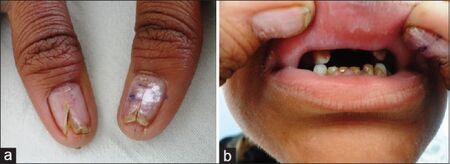Acro–dermato–ungual–lacrimal–tooth syndrome
| Acro–dermato–ungual–lacrimal–tooth syndrome | |
|---|---|
| Other names: ADULT syndrome | |
 | |
| a)Dysplastic ridged nails with central splitting b)decayed incisors | |
| Specialty | Medical genetics |
Acro–dermato–ungual–lacrimal–tooth syndrome (ADULT syndrome) is a rare genetic disease.[1] It is an autosomal dominant form of ectodermal dysplasia, a group of disorders that affects the hair, teeth, nails, sweat glands, and extremities.[2] The syndrome arises from a mutation in the TP63 gene.[3] This disease was previously thought to be a form of ectrodactyly–ectodermal dysplasia–cleft syndrome (EEC), but was classified as a different disease in 1993 by Propping and Zerres.[4]
Signs and symptoms
The age of onset for ADULT syndrome is generally either at a prenatal age or before a newborn reaches 4 weeks old. ADULT syndrome features include ectrodactyly, syndactyly, excessive freckling, lacrimal duct anomalies, dysplastic nails, hypodontia, hypoplastic breasts and nipples, hypotrichosis, hypohidrosis, broad nasal bridge, midfacial hypoplasia, exfoliative dermatitis, and xerosis.[5] The lack of facial clefting and ankyloblepharon are important because they exist in ectrodactyly–ectodermal dysplasia–cleft syndrome (EEC) but not in ADULT syndrome.[citation needed]
Patients with ADULT syndrome may also experience nail abnormalities, fine or thinned hair, fingernail or toenail dysplasia, melanocytic nevus, nail pits, skin ulcers, and thin skin.[6]
Cause
ADULT syndrome is due to autosomal dominant mutations of the TP63 gene, which encodes the p63 protein. TP63 mutations cause deformities because the p63 protein is critical in the embryonic development of limbs and other ectodermal tissues. Seven mutations have been found, the most common of which are R298Q and R243W, in which encoding for arginine is changed to glutamine at position 298 and tryptophan at position 243, respectively.[7][8] Other p63 genes mutation syndromes include ectrodactyly–ectodermal dysplasia–cleft syndrome (EEC) and Hay-Wells syndromes.[citation needed]
Diagnosis
In terms of the evaluation of ADULT syndrome we find that the following is done:[9]
- Clinical findings
- Molecular genetic testing (TP63 identify)
- Gene-targeted testing (to ascertain which TP63-related disorder)
Treatment
Currently there is no clinical practice guideline[9]
References
- ↑ Acro-. 2014. In ahdictionary.com. Retrieved Feb 7, 2014, from http://www.ahdictionary.com/word/search.html?q=acro&submit.x=0&submit.y=0 Archived 2022-08-09 at the Wayback Machine Dermo-. In ahdictionary.com. Retrieved Feb 7, 2014, from http://www.ahdictionary.com/word/search.html?id=D5151600 Archived 2022-08-09 at the Wayback Machine Lacrimcal. 2014. In ahdictionary.com. Retrieved Feb 7, 2014, from http://www.ahdictionary.com/word/search.html?q=lacrimal&submit.x=0&submit.y=0 Archived 2021-10-24 at the Wayback Machine Ungual. 2014. In ahdictionary.com. Retrieved Feb 7, 2014, from http://www.ahdictionary.com/word/search.html?q=ungual&submit.x=0&submit.y=0 Archived 2021-10-24 at the Wayback Machine
- ↑ Berk D. R., Armstrong N. L., Shinawi M., Whelan A. J. (2012). "ADULT syndrome due to an R243W mutation in TP63". International Journal of Dermatology. 51 (6): 693–696. doi:10.1111/j.1365-4632.2011.05375.x. PMID 22607287. S2CID 31178568.
{{cite journal}}: CS1 maint: multiple names: authors list (link) - ↑ Chan, I., Harper, J. I., Mellerio, J. E., & McGrath, J. A. (2004). ADULT ectodermal dysplasia syndrome resulting from the missense mutation R298Q in the p63 gene Wiley-Blackwell. doi:10.1111/j.1365-2230.2004.01643.x
- ↑ Propping P, Zerres K (1993). "ADULT-syndrome: an autosomal-dominant disorder with pigment anomalies, ectrodactyly, nail dysplasia, and hypodontia". Am J Med Genet. 45 (5): 642–8. doi:10.1002/ajmg.1320450525. PMID 8456838.
- ↑ Avitan-Hersh, E., Indelman, M., Bergman, R., & Sprecher, E. (2010). ADULT syndrome is caused by a mutation previously associated with EEC syndrome Wiley-Blackwell. doi:10.1111/j.1525-1470.2010.01131.x
- ↑ "ADULT syndrome". Genetic and Rare Diseases Information Center. Archived from the original on 12 February 2023. Retrieved 12 February 2023.
- ↑ Rinne T., Spadoni E., Kjaer K. W., Danesino C., Larizza D., Kock M.; et al. (2006). "Delineation of the ADULT syndrome phenotype due to arginine 298 mutations of the p63 gene". European Journal of Human Genetics. 14 (8): 904–910. doi:10.1038/sj.ejhg.5201640. PMID 16724007.
{{cite journal}}: CS1 maint: multiple names: authors list (link) - ↑ Chan I., Harper J. I., Mellerio J. E., McGrath J. A. (2004). "ADULT ectodermal dysplasia syndrome resulting from the missense mutation R298Q in the p63 gene". Clinical and Experimental Dermatology. 29 (6): 669–672. doi:10.1111/j.1365-2230.2004.01643.x. PMID 15550149. S2CID 42344213.
{{cite journal}}: CS1 maint: multiple names: authors list (link) - ↑ 9.0 9.1 Sutton, V. Reid; van Bokhoven, Hans (1993). "TP63-Related Disorders". GeneReviews®. University of Washington, Seattle. Archived from the original on 2019-02-17. Retrieved 2023-09-21.
External links
| Classification |
|---|